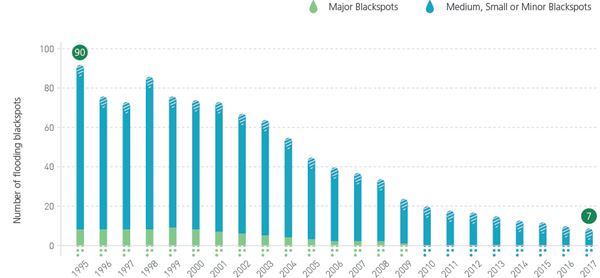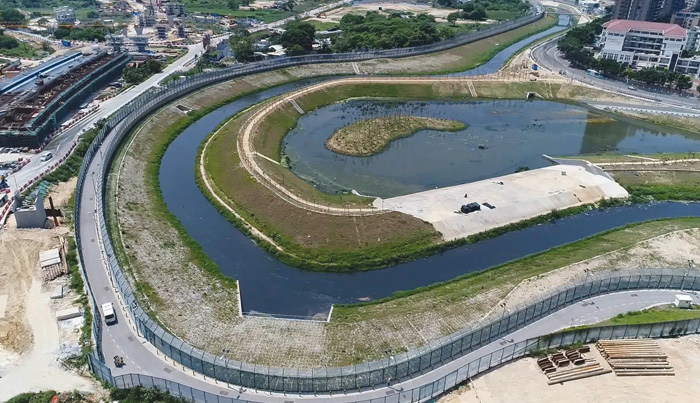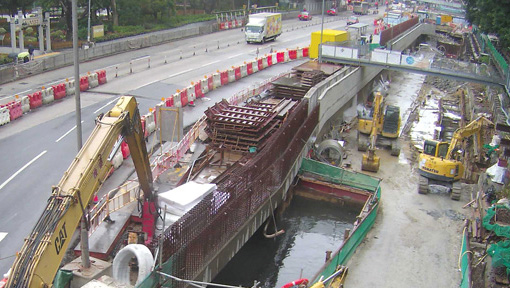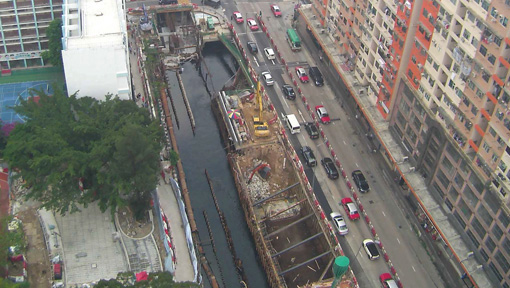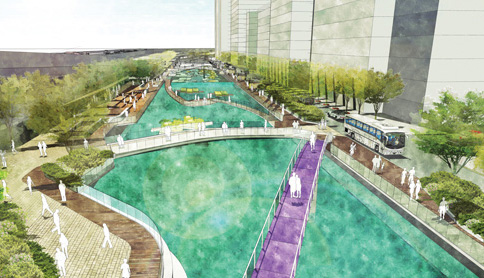Our Core Responsibilities
“Summer always brings rain. To carry away rainwater, we must keep our drains clear…” Both sewage treatment and rainwater drainage are closely tied to the daily lives of citizens. While endeavouring to provide world-class sewage and rainwater drainage services, we boost our resilience to increasing extreme weather. It is our goal to create a more livable environment for the public.
Overview of Flood Prevention in 2016-17 
Affected by extreme weather, Hong Kong faced frequent severe rainstorms that posed challenges to flood prevention in 2016. The annual total rainfall of that year was 3,027 millimetres, about 26% higher than the mean annual total rainfall of approximately 2,400 millimetres between 1981 and 2010. During the year, the Hong Kong Observatory issued one Black, five Red and 21 Amber Rainstorm Warnings. The Black Rainstorm Warning on 19 October 2016 was the first Black Rainstorm Warning ever issued in October since the inception of the Rainstorm Warning System in 1992. Over 100 millimetres of rainfall were recorded in most areas in Hong Kong that afternoon. The rainfall of 78.7 millimetres recorded between 3 and 4 p.m. on that day was also the highest hourly rainfall in October since records began in 1884.
To prevent flooding and safeguard the public, we have designed and constructed stormwater drainage systems with reference to international standards, and carried out regular inspections and maintenance works. In 2016-17, DSD implemented various flood prevention projects to upgrade the flood protection level and reduce the flood risks in relevant hazard areas. While ensuring that our facilities are operated properly, we are reviewing the Drainage Master Plans (DMPs) of various districts in stages, so as to formulate corresponding strategies for Hong Kong’s future development.
Another Flooding Blackspot Off the List
In early 2017, after evaluating the effectiveness of each completed drainage improvement works, we removed the flooding blackspot at the junction of Wong Chuk Hang Road and Nam Long Shan Road, thus reducing the total number of flooding blackspots in the territory from eight to seven.
Total Number of Flooding Blackspots
Among the seven remaining flooding blackspots, drainage improvement works for three have been commissioned. We are monitoring the effectiveness of these works as well as planning and designing improvement works for the remaining four. We will closely monitor their respective drainage conditions during the rainy season and endeavour to eliminate all flooding blackspots as soon as possible.
Operation and Maintenance of Existing Drainage Facilities
DSD manages about 2,400 kilometres of underground stormwater drains, 360 kilometres of engineered channels, 21 kilometres of drainage tunnels, and 36 stormwater pumping stations. In 2016-17, we continued with our regular inspections and preventive maintenance works of all stormwater drainage facilities to ensure smooth operation of the drainage systems. We also conduct functional and structural checks regularly and clear blockages before the wet season and after heavy rainstorms. Over 2,200 kilometres of drains and rivers were inspected over the past year.
![]()
Emergency and Response
- Emergency and Storm Damage Organisation (ESDO) operates round the clock to handle emergencies and floods.
- In adverse weather conditions, the Emergency Control Centre is activated to coordinate disseminating information relating to emergencies and allocation of resources to deal with extreme situations and to liaise with other government emergency units
![]()
Flood Storage
- During heavy rainstorms, stormwater in some urban areas is diverted to storage tanks for temporary storage to relieve the burden of downstream drainage systems
- Stormwater storage schemes at Tai Hang Tung, Sheung Wan and Happy Valley are in operation
- In rural areas, 27 village flood protection schemes are currently in operation, protecting 35 low-lying villages against flood hazards
- Low-lying village are enclosed by flood protection embankments. Runoffs within villages are stored temporarily in flood storage ponds during heavy rainstorms and subsequently discharged by pumping stations
![]()
Interception
- Stormwater is intercepted at upstream and diverted for direct discharge into the sea or rivers, thereby substantially mitigating the flood risk in downstream areas
- Four drainage tunnels, including the Kai Tak Transfer Scheme, and Hong Kong West, Lai Chi Kok and Tsuen Wan Drainage Tunnels, totaling about 21 kilometres in length, have been in operation for years
![]()
Drainage Improvement
- Drainage improvement works are carried out to straighten, widen and deepen rivers and to construct or enlarge underground drains
- Over 100 kilometres of rivers have been improved and about 93 kilometres of drains upgraded to date
Planning, Design and Construction of New Drainage Facilities
Drainage Master Plan (DMP) Reviews
DSD has completed eight DMP studies and three drainage studies covering all flood-prone areas in Hong Kong. To tie in with Hong Kong's future development and adapt to climate change, we review and update DMPs in a timely manner to assess the effectiveness of completed drainage improvement works. Where necessary, further improvement measures will be recommended.
Current progress
The review studies of DMPs for Yuen Long district, Northern New Territories and Happy Valley were completed in 2011 whereas, the improvement works proposed in the studies are under construction or design. The DMP Reviews for West Kowloon and East Kowloon were also completed in 2015. We are currently reviewing the DMPs for Lantau and Outlying Islands, Shatin and Sai Kung, Tai Po and Northern Hong Kong Island. Planning for the remaining review studies is underway.
Shenzhen River Regulation Project Stage IV
This project aims to improve the flood protection level for the river section between the Ping Yuen River estuary and Liantang/Heung Yuen Wai Boundary Control Point by improving a 4.5-kilometre section of the Shenzhen River (between Ping Yuen River and Pak Fu Shan), and constructing a flood retention lake of 80,000 cubic metres. We hope to create wetland habitats in the lake to enhance the ecological environment.
Current progress
Kai Tak River Improvement Works
The project aims to improve flood protection levels of East Kowloon by reconstructing and rehabilitating a 1.1-kilometre section of the Kai Tak River from Po Kong Village Road to Prince Edward Road East. A box culvert of about 400 metres long will also be constructed alongside the river upstream. We hope to ride on the opportunity to upgrade the river’s drainage capacity and revitalise into an urban green river corridor for public enjoyment.
Current progress
Upstream and midstream improvement works of the Kai Tak River commenced in October 2011 and December 2013 respectively and are scheduled for completion in 2018. The estimated project cost is about $2.8 billion.
Revitalisation of Tsui Ping River
We are conducting revitalisation works in Kowloon East, transforming a 1-kilometre nullah along King Yip Street, King Yip Lane and Tsui Ping Road into Tsui Ping River through environmental, ecological and scenic enhancement. The project also beautifies adjoining pavements as well as improves connectivity and walkability by providing riverside walkways and landscaped decks.

